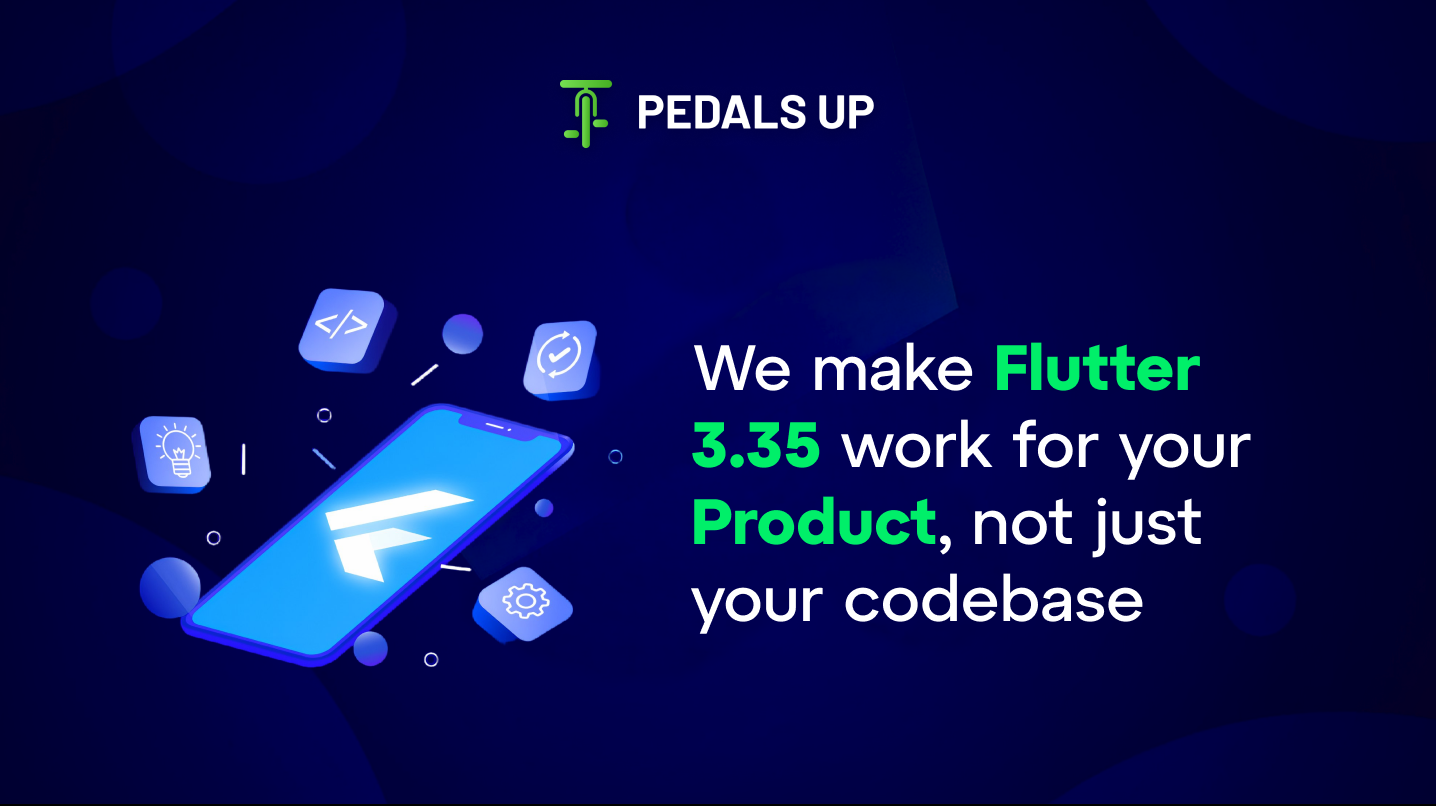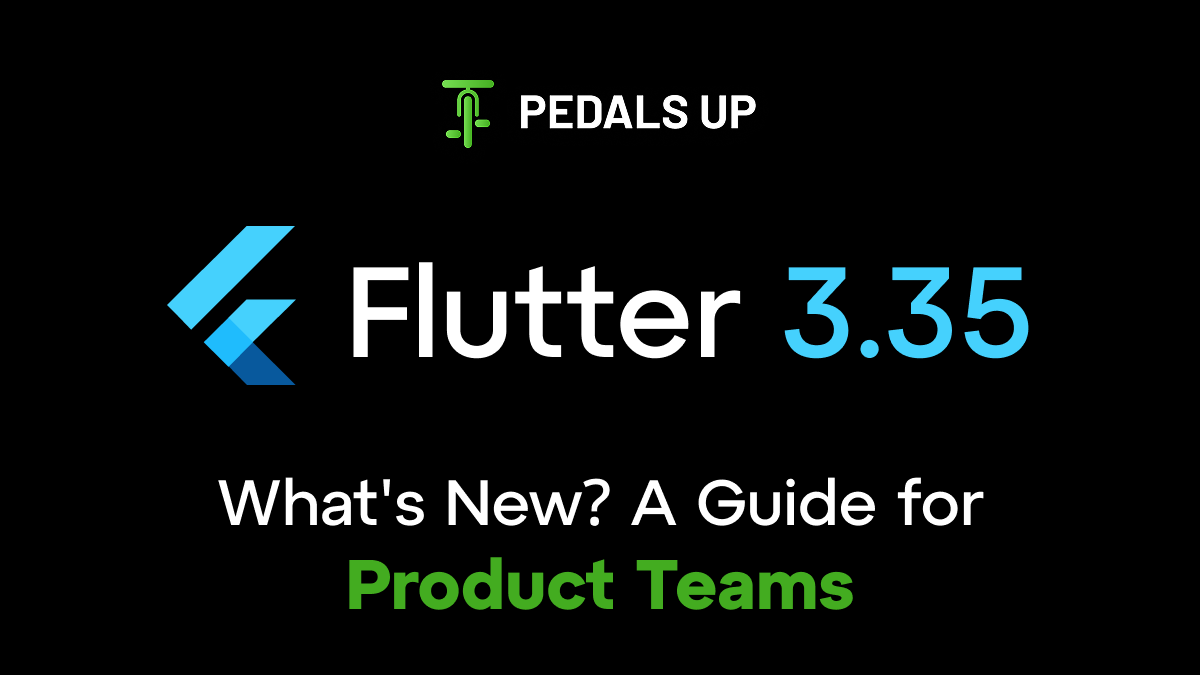Introduction
When you modify a button, save, and the browser instantly reflects the change without losing state, that’s the essential promise of Flutter 3.35. This release isn’t about marquee features; it’s about speeding up day-to-day developer work, making it less error-prone, and improving accessibility for those who depend on assistive technology. Whether you deploy mobile, web, or desktop apps, this release streamlines development and lifts baseline polish for users.
This guide summarizes the key changes, explains why product and engineering teams should care, and outlines real-world steps that a company named Pedals Up takes to translate these enhancements into quicker delivery and superior user experiences.
Stateful Hot Reload on the Web: Develop Like You Do on Mobile
What changed? Flutter 3.35 supports stateful hot reload for web development by default. This means you can modify UI code and watch the application update in place without losing runtime state.
Why it matters:
- Saves time spent recreating app flows while debugging.
- Allows product, design, and QA to approve UI changes live.
- Decreases context switching for engineers.
How teams use it: If you’re developing a dashboard or admin panel on Flutter web, you can now adjust a component, maintain the logged-in state, and instantly test edge cases. This eliminates much of the repeated clicking and setup that otherwise slowed down iteration.
Quick checklist to implement right away:
- Upgrade your dev environment to Flutter 3.35.
- Run applications in debug mode; no special flags are required for web hot reload.
- Add small, targeted UI tests to verify important flows during real-time edits.
What Pedals Up accomplishes with this change: We use stateful hot reload for client workshops and demos. Displaying live edits in an interactive session reduces decision loops and exposes unexpected UX problems sooner, which saves development time and gains client trust.
Widget Previews: Component-First Design Without the Hassle
What changed? Flutter 3.35 introduces an experimental Widget Previews workflow, which allows for standalone previews of specific UI parts. Think of it as a lightweight Storybook that’s native to the Flutter tooling.
Why it matters:
- Designers can inspect components without opening the whole app.
- Developers can test variations, alternative themes, locales, and font scales quickly.
- QA can reproduce and isolate visual bugs more confidently.
Real benefit example: Teams that break their UI into small, previewable widgets can identify layout and accessibility issues early on, before integration. This minimizes rework and accelerates sign-off.
How to integrate Widget Previews:
- Create preview entries for reusable parts.
- Share a preview build with stakeholders and designers.
- Attach unit tests to every preview to establish visual and semantic contracts.
Impeller Rendering Optimizations: Smoother Animations, Fewer Surprises
What changed? Under-the-hood work on the Impeller renderer improves stability and animation smoothness across platforms. These improvements boost visual fidelity without requiring you to rewrite your rendering code.
Why it matters:
- Motion feels consistent on mobile and desktop.
- Subtle rendering bugs that show up under load are less common.
- Users perceive the app as higher quality even when the feature set is unchanged.
What to check after upgrading:
- Run performance traces on complex screens.
- Check animation timing in crowded screens (transitions, lists).
- Test on target platforms to catch any platform-specific issues.
Accessibility and Semantics: Small Changes, Large Reach
What’s new? Flutter 3.35 contains multiple accessibility-related changes: better handling of semantics for scrollable widgets, improved text zooming and screen reader interaction, and tools that make it easier to label dynamic content.
Why it’s important:
- Less manual tweaking is needed when supporting TalkBack, VoiceOver, or other assistive technologies.
- Improved out-of-the-box accessibility guideline compliance.
- Reaching out to users who rely on accessibility tends to enhance conversion and retention for all.
Practical steps for product teams:
- Use automated accessibility scans in addition to one manual screen reader pass.
- Utilize the new semantics helpers so that dynamic or custom widgets announce state changes.
- Make accessibility a part of the acceptance criteria for UI tickets.
How this translates to business value: Improving accessibility decreases customer support friction, reduces legal risk in regulated industries, and increases your addressable audience. For most products, this has a direct impact on revenue.
Material and Cupertino Updates: More Polish With Less Effort
What’s changed? The Material and Cupertino libraries saw incremental improvements: new form fields, enhanced navigation components, greater shape and feedback behaviors, and more consistent platform-specific behavior.
Why it’s important:
- You get contemporary UI affordances without rebuilding pieces.
- You get a more native look and feel throughout iOS and Android with less platform-specific code.
- It’s easier to align design systems with platform conventions.
Implementation hints:
- Review custom components versus native widgets; replace where the native widget now meets your requirements.
- Use these enhanced widgets to lower maintenance overhead and enhance accessibility.
Tooling, Docs, and Developer Ergonomics
What changed? Documentation and tooling for previews, migrations, and AI-powered helpers are further improved. The release comes with guides and examples that make adopting new patterns less difficult.
Why it matters:
- Improved onboarding for new engineers.
- Cleaner migration paths when widget behavior changes.
- Concrete examples reduce guesswork.
Where to look: Flutter’s official What’s New page has the complete breakdown and migration notes. Use that as the source of truth: https://docs.flutter.dev/release/whats-new
Migration and Breaking-Change Checklist
What to expect: 3.35 smooths most workflows but contains some breaking changes and API updates. Common items for teams to check include theme normalization, some form field property updates, and small widget behavior tweaks.
Migration steps we suggest:
- Read the release notes and breaking-change guide.
- Run your test suite under 3.35 in a feature branch.
- Manually test key user journeys: login, payments, content creation, and onboarding.
- Fix deprecation warnings and migrate CI to use the new SDK.
A Brief Client Example
Context: An anonymized client,a mobility app with bookings and in-app payments,required faster UI iteration and more stable accessibility behavior for voice-over users.
What changed after the upgrade?
- Stateful web hot reload shortened the time to iterate on the admin portal.
- Widget Previews allowed designers to test booking form variations without opening the app.
- Accessibility changes needed fewer ad-hoc patches and reduced QA cycles.
Outcome: The client saw accelerated releases, fewer post-release UI patches, and improved accessibility scores as measured by audit tools. Overall, the net effect was a more consistent launch rhythm and improved user feedback.
Conclusion

Flutter 3.35 is a sensible update. It doesn’t turn the platform upside down. Instead, it simplifies the day-to-day task of app building and shipping: more rapid iteration, tidier component workflows, smoother rendering, and better accessibility. For quality- and speed-sensitive teams, these are the improvements that add up over releases.
Why work with Pedals Up? We don’t merely update your SDK. We align platform changes with your release pipeline, regression-audit code, and fine-tune the experience so users can feel the difference. If you need someone to translate Flutter 3.35’s enhancements into tangible delivery victories for your mobile app, we can assist.




